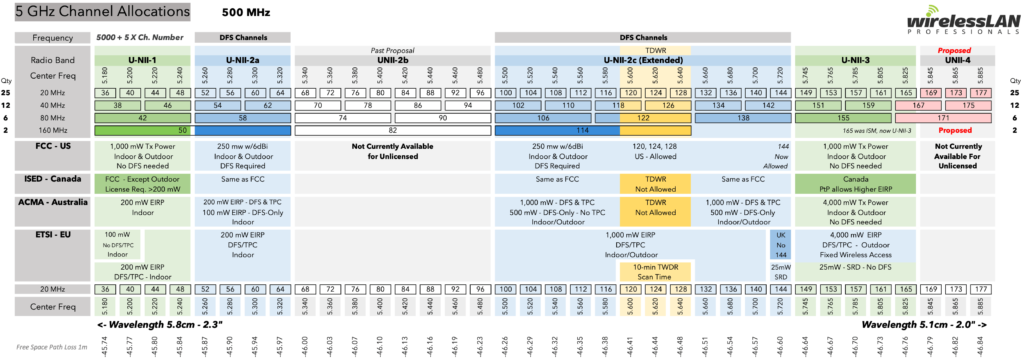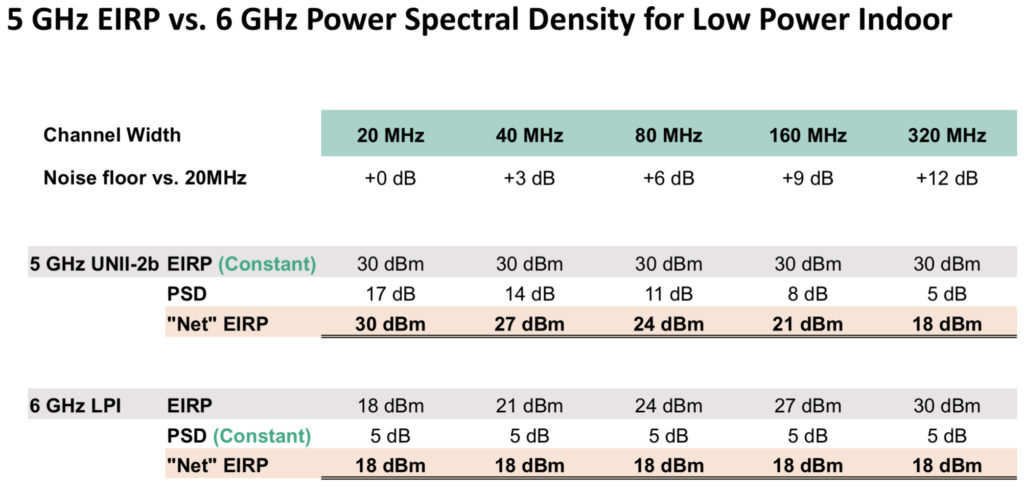The 5.850-5.925 GHz frequency band of spectrum, otherwise known as U-NII-4 was approved for unlicensed use on May 3, 2021, effective July 2, 2021. Well, kind of. Let me explain…
The FCC has reworked the band plan and opened the lower 45 MHz (5.850-5.895 GHz) for unlicensed use, while still allowing the Intelligent Transportation System (ITS) radio service to use the upper 30 MHz (5.895-5.925 GHz). ITS licensees have 1 year from the effective date (7/2/21) of the First Report and Order to vacate the lower 45 MHz and move to the upper 30. While we didn’t get the full band which would have given us even one more additional channel, we did get three additional 20 MHz channels, two 40 MHz channels, one additional 80 MHz, and 160 MHz channel when combined with the U-NII-3 band. See the images below:


Yet, no one seems interested, at least from what I can tell. I guess the Wi-Fi world is sitting fat and happy with all that 6 GHz spectrum coming so three additional 20 MHz or two 40 MHz channels doesn’t move the needle much. Don’t get me wrong, I understand. 1200 MHz of spectrum is nothing to sneeze at, especially in comparison to 45! However, lack of spectrum has been an ongoing issue and an important consideration in terms of channel reuse, particularly in high-density (HD) and very high-density (VHD) environments. So shouldn’t 3 additional channels mean something? I think so, but it seems that most vendors* (excluding Aruba) aren’t interested in supporting it and most people aren’t interested in using it. Despite all of that, let’s look at the rules for unlicensed use in the lower 45 MHz of the band and hypothesize why there’s no hype or love for U-NII-4.
- For now, the spectrum is only allowed for indoor use, but I’ll circle back to this later. This allows time for the incumbents to move out of the spectrum and helps prevent harmful interference that could affect vehicular safety-related applications.
- Like low power indoor (LPI) devices in the 6 GHz band, APs cannot be battery powered (except backup power in the event of a power outage), cannot be housed in weatherized enclosures or be weather resistant, and must use integrated antennas. Additionally, APs must be marketed for indoor-use only and include a label stating “FCC regulations restrict operation to indoor use only.” Sound familiar?
- Indoor APs are limited to an EIRP spectral density of 20 dBm/MHz with a maximum EIRP of 36 dBm over the entire channel bandwidth (e.g., 33 dBm/20 MHz and 36 dBm/40 MHz) to protect federal radar operations. When combined with the adjacent UNII-3 band for 80 or 160 MHz channels, EIRP is also limited to 36 dBm. If you’re unfamiliar with spectral density and dBm/MHz, don’t worry. It wasn’t until I read the notice of proposed rule-making for 6 GHz that I came across it and learned more about it. Wes Purvis and Jake Snyder wrote a great blog post on Mist’s website about it. To summarize, power spectral density (PSD) is the amount of power allowed over a given bandwidth. LPI devices in 6 GHz will use a constant PSD, which allows the EIRP to be doubled (+3 dB) for every increase in channel bandwidth. This allows the SNR or net EIRP to remain unaffected, despite the 3 dB increase of the noise floor when doubling channel bandwidth. Which brings me back to the 20 dBm/MHz EIRP limit. Devices in the U-NII-4 band will use a constant EIRP like the other 5 GHz bands which is affected by the 3 dB increase in the noise floor because EIRP is capped across the different bandwidths.
- Wi-Fi extenders and mesh devices are allowed to operate at the same power levels as indoor APs, provided they comply with all the other rules above. One important note here is that these devices must be used within the same physical structure, meaning they cannot be used to connect separate buildings or structures.
- Client devices are required to operate under the control of an AP and are limited to power levels 6 dB below the limits for the AP. (Client-to-client is prohibited)

Back to the topic of outdoor use in rule #1… I did say that outdoor unlicensed use was prohibited. However, the FCC also ruled that outdoor unlicensed would be permitted in certain specified locations through special temporary authority or other regulatory processes if it doesn’t cause harmful interference to the incumbents. So, there are exceptions to the rule.
At the same time that the FCC adopted the proposed rules, they also submitted a further notice of proposed rulemaking which could change a few things.
- For example, the FCC wants to raise the indoor spectral density to 23 dBm/MHz or 36 dBm EIRP for all channel bandwidths starting 1 year after the effective date of the first report and order OR the effective date of a second report and order that would approve the proposed power increases.
- The FCC wants to fully approve outdoor use. If that happens, special considerations will be required in point-to-point (P2P) and point-to-multipoint (P2MP) applications to protect federal radar systems. Exclusion zones will be created (similar to what you’ll see in 6 GHz) where unlicensed use will be prohibited. This implies that devices will need some type of geolocation functionality (like standard power devices in 6 GHz). They are asking for comments on how best to approach this requirement, with the goal of keeping device costs and complexity down.
- There’s also a proposal to increase the outdoor power limits to 23 dBm/MHz or 36 EIRP to match U-NII-3 devices to maximize the full benefits of combining channel widths across both bands. With one exception. P2P power limits from U-NII-3 will not be adopted to protect incumbent radar operations since there are no restrictions on antenna gain in U-NII-3 P2P deployments; adopting the P2P power rules would also increase complexity by requiring larger exclusion zones to address the possibility of more interference.
- The FCC has requested comments to determine if client-to-client communication can be allowed once ITS moves out of the spectrum since only federal radiolocations (~30 sites) will need to be protected. Allowing client-to-client communication would open up opportunities in the VR/AR space. This is consistent with the FCC’s vision for very low power indoor devices in 6 GHz.
Why is there no hype around this? I honestly don’t know, but I have a couple of ideas. For one, it comes down to marketing and money. Unlike 6 GHz, new hardware isn’t required according to the FCC in the report and order. That’s technically true, but there should be a huge asterisk next to that statement. If you remember, devices must be marketed for indoor-use only and include that special labeling. Vendors don’t currently do that with their 2.4/5 GHz only 802.11ax APs so this would indeed require new hardware. On top of that, when I spoke with some colleagues who know more about radio than I do, the possibility was brought up that existing hardware inside the APs might not be able to even support the additional spectrum, which guess what? Requires new hardware. With new hardware comes new design, new coding, and new certifications.
Could they make a few changes to their marketing message and in the supply chain to add a label? I guess it’s possible, but that would be a large undertaking without guaranteeing something else didn’t break at the same time. Why not wait until they release their 6 GHz LPI APs that have the same requirements? After all, 6 GHz is where all the attention and $$$ will be, so it makes sense to me to wait it out and react to the market’s demand later. The prospect of spending money on something customers aren’t actively asking for doesn’t seem appealing to me when you’ve got a cash cow like 6 GHz on the horizon. I’m sure it doesn’t appeal to them either.

Another reason I think vendors are avoiding this band is due to the potential for sideband interference. The U-NII-4 and U-NII-5 band (starts at 5.925 GHz) are immediately adjacent to each other. There is 20 MHz of guard band between the lower edge of the U-NII-5 band and channel 1, but I think the fear is that if an AP on an upper U-NII-4 channel like 177 is placed near an AP on a lower U-NII-5 channel like 1, you could potentially have adjacent channel interference depending on transmit power and proximity. Aruba claims they have it figured out with their ultra tri-band filtering, but I guess we’ll have to see if this comes to fruition. It also concerns me that I have no idea whether some of the most popular client devices currently support the additional spectrum because their FCC listings only list support up through U-NII-3. So, is U-NII-4 DOA? Is it too little, too late by the FCC?

I’d like to know your thoughts on this. Let’s start a conversation on Twitter.
* Credit given where credit is due. Aruba openly advertises U-NII-4 support on their AP-630 series data sheet, but it is new hardware. If other vendors support it, let me know and I’ll update this post, but I haven’t seen it mentioned for most newer APs.